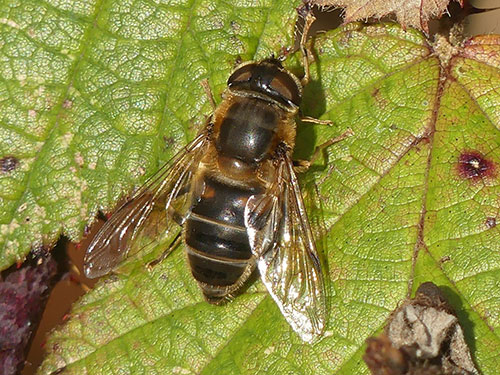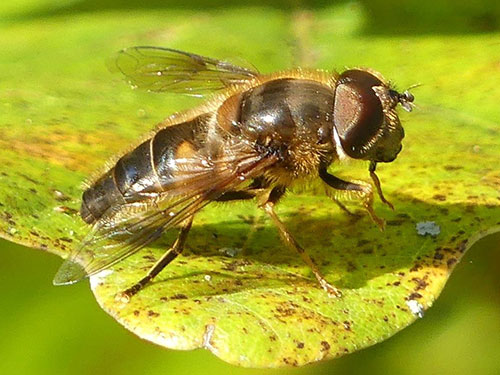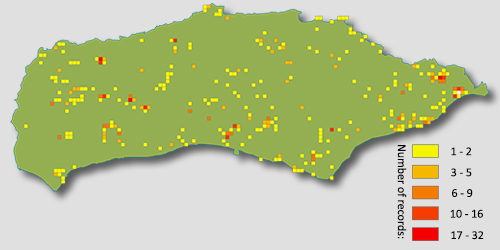


Male Eristalis pertinax Beachy Head, East Sussex. Note that pronounced bulge in one of the wing’s veins which identifies it as one of the Eristalini hoverflies.
Photo: Steven Falk

Female Eristalis pertinax Herstmonceux, East Sussex
Photo: Mike Mullis

Male Eristalis pertinax Herstmonceux, East Sussex. Note the yellow tarsi (‘feet’) on the front and middle legs compared to the dark tarsi of the hind leg.
Photo: Mike Mullis

Map showing scattered distribution of Eristalis pertinax records in Sussex. The apparent coastal and downland bias may well be a result of recording effort rather than a true reflection of distribution.
Everyone loves bees don’t they? The recent revelations that our bees are in decline has prompted protests and petitions and have highlighted the vital service these buzzing pollinators provide to our planet. Yet many other pollinators which provide the same service don’t get the same level of public support. So in April I’m raising my banner for the hoverflies.
There are almost 300 species of hoverfly in the UK and one of the first to appear each year is Eristalis pertinax - the Tapered Drone Fly.
At first glance you may mistake this hoverfly for a honeybee but that’s exactly what Eristalis pertinax wants you to think. This isn’t an attempt to jump on the bee bandwagon to win some attention - it’s all a cunning strategy called Batesian mimicry. The UK’s hoverflies come in many shapes, colours and sizes but most of them sport yellow/orange markings and black stripes making them easily confused for wasps, bees, hornets and bumblebees. But unlike bees and wasps hoverflies are harmless. They don’t sting and can’t bite. But they have discovered you don’t have to actually be dangerous to deter predators - you just have to look like something that’s dangerous. It’s a strategy you can try for yourself. To avoid unwanted attention simply strap on a fake bomb and a wear a big hat with TERRORIST in big letters across it and I guarantee nobody will want to talk to you. Except maybe the police.
Some hoverflies are so much like bees and wasps that only their mother could tell them apart (check out my favourite - the furry bumblebee mimic Eristalis intricarius) yet their devious mimicry isn’t the most incredible feature about them. Their wings are the things. Hoverflies (like all flies) have just two wings (half as many wings as bees and wasps). The looped wing venation is a way to identify the Eristalini and Eristalis pertinax has that noticeably tapered abdomen and the front and middle tarsi (the end section of the leg) are yellow.
Whereas other flies keep their wings straight hoverflies have the inclination to incline their wings and an angled downward stroke at a remarkable rate of 120 beats per second allows them to fly to a most amazing place: nowhere. Hoverflies have become the motionless masters of mid-air. In April you’ll spot Eristalis pertinax doing just that - hovering around sunny woodland rides defending its territory.
The looped venation on their wings is a way to identify the Eristalini and Eristalis pertinax males have that noticeably tapered abdomen and in both sexes the front and middle tarsi (the end section of the leg) are yellow.
It’s not all sitting around in the sky though. During their few days of life hoverflies fight, fornicate and feed. While busy collecting energy-giving nectar and protein-rich pollen they inadvertently provide that vital pollination service to our flowers and crops. And hoverflies have earned the title of ‘The Gardeners Friend’. About 40% of them have a larval stage which is basically a tiny crawling stomach that roams around your flowerbed eating pesky aphids. Pollination, pest control - next thing you know these beneficial little insects will be mowing the front lawn for us too.
Eristalis pertinax larvae however are, like many other species, aquatic and filter feed on the tiny organisms found in decaying matter in ponds. These type of hoverfly larvae breathe through a long tube and have earned the name ‘rat-tailed maggot’ a phrase I find pleasing to mention under my breath each time Nigel Farage appears on TV.
If you’re interested in recording hoverflies I’d recommend the excellent identification guide ‘Britain’s Hoverflies’ by Stuart Ball and Roger Morris. Steven Falk has an impressive catalogue of hoverfly photos on his Flickr site. To become more involved with fly recording in Sussex join the Sussex Fly Group who organise field trips and indoor identification sessions throughout the year.
Michael Blencowe, Sussex Fly Group
Every month it is our aim to highlight a species that is “in-season” and, although not necessarily rare or difficult to identify, has been highlighted by our local recording groups as being somewhat under-recorded and for which new records would therefore be welcomed.
If you or your recording group are aware of species such as this then please contact Bob Foreman.